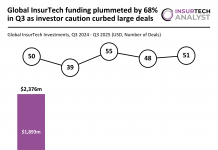In the competitive landscape of insurance underwriting, the integration of risk data is emerging as a secret weapon to enhance the performance of your underwriting team. One way this can be exploited is through the use of loss control, a risk management method aimed at decreasing the likelihood of losses occurring and minimising the impact of any that do happen. Due to the clear benefits of this, numerous key industry players are now claiming that advanced loss control practices can transform the traditional underwriting processes, reducing claims while increasing renewals and premiums.
FinTech Global‘s Harry Slade sat down with Risk Control Tech‘s AVP of Sales, David Pittman, to delve into the potential benefits of loss control – and mused as to whether it could become a silver bullet for underwriting teams globally.
Opening up on loss control’s newfound significance in the market, Pittman said, “We have seen a significant change over the last few years in how insurance organisations are leveraging loss control as a discipline. What was once just an inspection/survey function, is now becoming by far the most granular data source on a commercial carrier’s book of business.”
Boosting your loss control functions
Most insurance carriers already have some form of loss control practice in place today, whether it’s a home insurer that has deployed sprinklers and smoke detectors in the house to reduce the risk of a house fire or a much more well-developed commercial system for industrial risk.
But this is really surface-level thinking. The potential for loss control is much higher when you consider the additional level of granularity of risk data that loss control teams can produce.
If leveraged effectively, this can enable your underwriting team to delve into the nature of the risk present in an insured’s operations and gain a more holistic understanding of what they’re covering.
By having access to detailed and specific risk data, underwriters can better assess the unique risks associated with each policyholder.
This comprehensive view allows them to make more informed decisions about coverage terms, premiums, and risk mitigation strategies. It also helps identify patterns and trends that might not be visible with broader data, leading to more accurate predictions of future risks and losses.
This deeper insight not only enhances the ability to protect the insurer’s financial stability but also enables the provision of more tailored and effective risk management advice to policyholders, improving overall safety and satisfaction.
Pittman explained, “We believe it is an intuitive next step to further enable disciplines within insurance that are already exist. Loss control is definitely at the forefront of that.”
Adding accuracy to underwriting
Insurance is an inherently analytical game, centred around numbers, and often viewed by wider eyes as rather clinical in practice. However, despite the clear focus on data and information, it is often leveraged ineffectively as the insurance sector fails to move with the rapid technological transformation that is impacting the wider financial space.
Your book of business, like anything, needs to be accurately measured if it is going to be bettered in terms of risk profile. As previously mentioned, many insurance companies already invest in loss control teams. So, by pushing on more, they could utilise improved tools to collect better use data and make their gains much more widespread. Therefore, enabling them to enrich other departments throughout their firm.
Risk prediction is another key area where insurers can target if they are going to add a greater sense of accuracy to their underwriting teams. Tactics like cross-referencing historical claims, and utilising past data can enable your team to select the risks they would want to cover in the future, as Risk Control Tech’s Pittman explains.
“Historically, loss control reports are long form documents that underwriters view at the time of renewal and then they get indexed away to never really be unearthed again. The delta between what is available in a renewal or application submission and what is available in a loss control report is not only significant, but it is actionable as well. It just follows that we want to make the data that matters front and centre for underwriting.
Easing the underwriting burden
In today’s fast-paced insurance landscape, your underwriting team’s greatest asset is their analytical prowess, not the manual tasks that often bog them down. To enhance their efficacy, it is crucial to streamline their workflow by minimising redundant data entry, consolidating system logins, and automating task creation for high-risk accounts.
By giving underwriters the tools that they need through the use of loss control risk data – they will in turn reward you through the quality of their work as they have more-informed data to make quicker, and more effective decisions.
This is even more paramount when you consider that just 30% of an underwriter’s time is spent doing risk analysis and generating quotes, according to research from Accenture.
Loss control in turn will allow your high-quality team to highlight their skills and allow them to adopt a macro perspective of the business, recognise strengths and weaknesses within their portfolio, and decide where to concentrate their efforts for deeper analysis.
“High level loss control data like the number of open recommendations on an account is, and always will be relevant. But we are really starting to see the needle get moved when an underwriting team has access to the data across their entire book of business within a given constraint. This enables insights like industry-wide benchmarking from client to client, seeing how client A compares to the rest of your book of business from an inherent risk perspective,” Pittman remarked
Enhancing customer satisfaction
Ensuring customer renewals in the insurance industry hinges on providing comprehensive insurance services, not merely coverage.
Maximising the value of every customer interaction is crucial, particularly since claims are often the sole touchpoint for many clients.
This is doubly important, as according to Zendesk, 50% of consumers claim that one negative experience is enough to drive them away to a competitor.
Proactively engaging through loss control not only adds significant value but also positively influences clients’ perceptions of their providers. By leveraging loss control teams as an extension of the customer service department, insurers can enhance attention to each account, thereby improving service quality and customer satisfaction.
Scott Claffey, VP National Accounts Risk Control. Great West Casualty Company, stated, “We can help them (Underwriting) sell (and retain) policies. We do that by bringing the types of materials, products, services that our clients need to help them manage and mitigate risk. We do that by making sure we have the best minds in the business, but also that we are utilising the best tools to optimise our service.”
Ultimately, in insurance, and all walks of life, the service itself becomes the product, and delivering value through polished and professional interactions, aligned branding, and consistent documentation, instils customer confidence in the insurance provider.
By adopting an efficient loss control product, insurers can bolster their operation in a plethora of ways. As the industry only gets more competitive and sophisticated, finding a silver bullet can be difficult – but loss control has seemingly taken up that mantle across the InsurTech space.
Copyright © 2024 InsurTech Analyst










